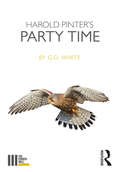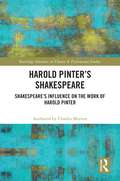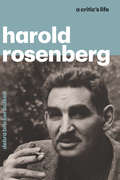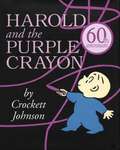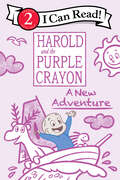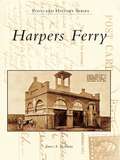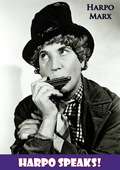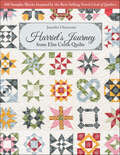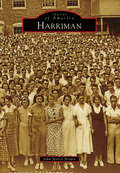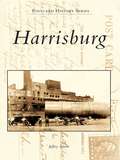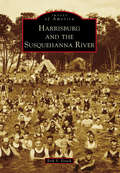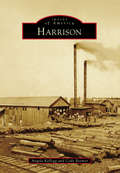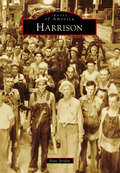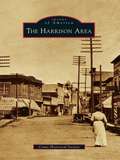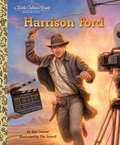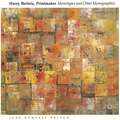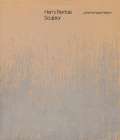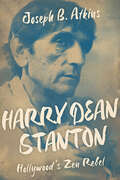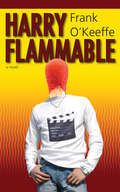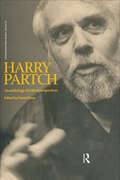- Table View
- List View
Harold Pinter's Party Time (The Fourth Wall)
by White G. D.‘All you have do is shut up and enjoy the hospitality.’ Terry Harold Pinter’s Party Time (1991) is an extraordinary distillation of the playwright’s key concerns. Pulsing with political anger, it marks a stepping stone on Pinter’s path from iconic dramatist of existential unease to Nobel Prize-winning poet of human rights. <P><P> G. D. White situates this underrated play within a recognisably ‘Pinteresque’ landscape of ambiguous, brittle social drama while also recognising its particularity: Party Time is haunted by Augusto Pinochet’s right-wing coup against Salvador Allende’s democratically elected government in Chile. <P><P> This book considers Party Time and its confederate plays in the dual context of Pinter’s literary career and burgeoning international concern with human rights and freedom of expression, contrasting his uneasy relationship with the UK’s powerful elite with the worldwide acclaim for his dramatic eviscerations of power.
Harold Pinter's Shakespeare: Shakespeare's Influence on the Work of Harold Pinter (Routledge Advances in Theatre & Performance Studies)
by Charles MortonThis book charts the impact of Shakespeare’s works on Harold Pinter’s career as a playwright. This exploration traces Shakespeare’s influence through Pinter’s pre-theatre writings (1950-1956), to his collaboration with Sir Peter Hall (starting properly at the RSC in 1962 and continuing until 1983), and a late, unpublished screenplay for an adaptation of The Tragedy of King Lear (2000). Adding to studies of playwrights such as Samuel Beckett and James Joyce as significant influences on Harold Pinter’s work, this study aims to highlight the significant and lasting impact that Shakespeare had both formatively and performatively on the playwright’s career. Through exploring this influence, Morton gains not only a greater understanding of the shaping of Pinter’s artistic outlook and how this affected his writing, but it also sheds light on the various forms of Shakespeare’s continued influence on new writing, and what can be gained from this. This study will be of great interest to students and scholars in theatre and performance studies.
Harold Rosenberg: A Critic‘s Life
by Debra Bricker BalkenDespite being one of the foremost American intellectuals of the mid-twentieth century, Harold Rosenberg (1906–1978) was utterly incapable of fitting in—and he liked it that way. Signature cane in one hand and a cigarette in the other, he cut a distinctive figure on the New York City culture scene, with his radiant dark eyes and black bushy brows. A gangly giant at six foot four, he would tower over others as he forcefully expounded on his latest obsession in an oddly high-pitched, nasal voice. And people would listen, captivated by his ideas. With Harold Rosenberg: A Critic’s Life, Debra Bricker Balken offers the first-ever complete biography of this great and eccentric man. Although he is now known mainly for his role as an art critic at the New Yorker from 1962 to 1978, Balken weaves together a complete tapestry of Rosenberg’s life and literary production, cast against the dynamic intellectual and social ferment of his time. She explores his role in some of the most contentious cultural debates of the Cold War period, including those over the commodification of art and the erosion of individuality in favor of celebrity, demonstrated in his famous essay “The Herd of Independent Minds.” An outspoken socialist and advocate for the political agency of art, he formed deep alliances with figures such as Hannah Arendt, Saul Bellow, Paul Goodman, Mary McCarthy, Jean-Paul Sartre, Willem de Kooning, and Jackson Pollock, all of whom Balken portrays with vivid accounts from Rosenberg’s life. Thoroughly researched and captivatingly written, this book tells in full Rosenberg’s brilliant, fiercely independent life and the five decades in which he played a leading role in US cultural, intellectual, and political history.
Harold Rosenberg: A Critic‘s Life
by Debra Bricker BalkenDespite being one of the foremost American intellectuals of the mid-twentieth century, Harold Rosenberg (1906–1978) was utterly incapable of fitting in—and he liked it that way. Signature cane in one hand and a cigarette in the other, he cut a distinctive figure on the New York City culture scene, with his radiant dark eyes and black bushy brows. A gangly giant at six foot four, he would tower over others as he forcefully expounded on his latest obsession in an oddly high-pitched, nasal voice. And people would listen, captivated by his ideas. With Harold Rosenberg: A Critic’s Life, Debra Bricker Balken offers the first-ever complete biography of this great and eccentric man. Although he is now known mainly for his role as an art critic at the New Yorker from 1962 to 1978, Balken weaves together a complete tapestry of Rosenberg’s life and literary production, cast against the dynamic intellectual and social ferment of his time. She explores his role in some of the most contentious cultural debates of the Cold War period, including those over the commodification of art and the erosion of individuality in favor of celebrity, demonstrated in his famous essay “The Herd of Independent Minds.” An outspoken socialist and advocate for the political agency of art, he formed deep alliances with figures such as Hannah Arendt, Saul Bellow, Paul Goodman, Mary McCarthy, Jean-Paul Sartre, Willem de Kooning, and Jackson Pollock, all of whom Balken portrays with vivid accounts from Rosenberg’s life. Thoroughly researched and captivatingly written, this book tells in full Rosenberg’s brilliant, fiercely independent life and the five decades in which he played a leading role in US cultural, intellectual, and political history.
Harold and the Purple Crayon
by Crockett JohnsonThis timeless classic kindles every child's imagination as it follows Harold's adventure with his purple crayon. Images and image descriptions available.
Harold and the Purple Crayon
by Crockett Johnson<p>From beloved children’s book creator Crockett Johnson comes the timeless classic Harold and the Purple Crayon! <p>One evening Harold decides to go for a walk in the moonlight. Armed only with an oversize purple crayon, young Harold draws himself a landscape full of wonder and excitement. <p>Harold and his trusty crayon travel through woods and across seas and past dragons before returning to bed, safe and sound. Full of funny twists and surprises, this charming story shows just how far your imagination can take you.</p>
Harold and the Purple Crayon: A New Adventure (I Can Read Level 2)
by Alexandra WestHarold and the Purple Crayon is coming to the big screen in January 2023, featuring stars Zachary Levi, Zooey Deschanel, Lil Rel Howery, and Ravi Patel!Join Harold, Porcupine, and Moose as they surf the ocean’s waves, get lost in the big city, learn to ride a motorcycle, and discover a world much bigger than they could ever imagine. This early reader is a level 2 I Can Read, which means it’s geared for kids who read on their own but still need a little help. Whether shared at home or in a classroom, the engaging stories, longer sentences, and language play of Level Two books are proven to help kids take their next steps toward reading success.
Harold and the Purple Crayon: Meet Harold! (I Can Read Level 1)
by Alexandra WestHarold and the Purple Crayon is coming to the big screen in January 2023, featuring stars Zachary Levi, Zooey Deschanel, Lil Rel Howery, and Ravi Patel!Meet Harold and his best friends, Moose and Porcupine, as they go on an incredible journey with the help of Harold’s magical purple crayon!Harold and the Purple Crayon: Meet Harold is a Level One I Can Read book, which means it’s perfect for children learning to sound out words and sentences. Whether shared at home or in a classroom, the short sentences, familiar words, and simple concepts of Level One books support success for children eager to start reading on their own.
Harpers Ferry
by James A. BeckmanHarpers Ferry, located at the confluence of the beautiful Shenandoah and Potomac Rivers, offers visitors a breathtaking view described by Thomas Jefferson as a "scene worth a voyage across the Atlantic." From George Washington's 1796 establishment of the federal armory, through John Brown's 1859 raid to foment slave rebellion and Civil War battles, and to one of the first successful colleges for African Americans, Harpers Ferry has played a significant role in America's history. Hundreds of vintage postcards, many of which are very scarce today, depict this history, the various scenic views and buildings in town, and the daily lives of townspeople over the last century.
Harpo Speaks!: The Autobiography (Limelight Ser.)
by Harpo Marx Rowland BarberFirst published in 1961, this is the autobiography of Harpo Marx, the silent comedian of The Marx Brothers fame.Writing of his life before, during, and after becoming famous by incorporating lovely and humorous stories and anecdotes, Harp Marx tells of growing up in a rough neighborhood and being poor, being bullied and dropping out of school, teaching himself to read, write, tell time, and to play the piano and harp.He speaks of his close relationships with his family members, particularly his mother and brother Leonard (Chico), who would become his partner-in-crime on screen, and the profound effect that the death of his parents Sam and Minnie had on him.Filled with insider tales of his antics on and off stage, and the hard graft he and his brothers put into reaching their level of success, the reader becomes privy to a rare glimpse into Marx’ thoughts on everything and everyone he had the privilege of working with.The book reveals the friendships he forged and the blows he was dealt in show-business, and of his marriage to his wife, actress Susan Fleming, with whom he adopted four children and built a ranch on which they lived happily ever after, along with numerous animals.A thoroughly enjoyable read.“This is a riotous story which is reasonably mad and as accurate as a Marx brother can make it. Despite only a year and a half of schooling, Harpo, or perhaps his collaborator, is the best writer of the Marx Brother. Highly recommended.”—Library Journal“A funny, affectionate and unpretentious autobiography done with a sharply professional assist from Rowland Barber.”—New York Times Book Review“This is a racy autobiography by the mute Marx Brother with the rolling eyes, oversized pants and red wig who could send a glissando reeling over his harp.[…] It is enjoyable reading and polished writing...”—Kirkus Review
Harriet’s Journey from Elm Creek Quilts: 100 Sampler Blocks Inspired by the Best-Selling Novel, Circle of Quilters
by Jennifer ChiaveriniThe extraordinary ‘Harriet’s Journey’ 100-block sampler quilt from Jennifer Chiaverini Author and quilt designer Jennifer Chiaverini is back with a beautiful new sampler based on her ninth Elm Creek Quilts novel. In Circle of Quilters, one woman’s discovery of an exquisite sampler quilt utterly changed her fate; immerse yourself in the story and create the same 100-block sampler of this best-selling novel! Follow the step-by-step instructions to cut and piece blocks, or simply use the included foundation piecing patterns—the choice is yours. Mingling vintage favorites with never-before-seen designs, the blocks will intrigue quilters of all skill levels. An inspirational gallery shows off the 6” finished squares in a variety of settings. Best-selling novelist and quilter returns with another Elm Creek Quilts masterpiece Recreate 100 blocks—a mix of new and classic designs—for adventurous beginners and experienced quilters Traditionally piece blocks or use foundation patterns
Harriman
by John Norris BrownHarriman was born of the dreams of prohibitionists who believed they could found a model city of industry where workers would be free from the corrupting influences of demon rum. In the beginning, Harriman appeared to be on the road to achieving this vision: in its first two years, the population exploded from only two farms in 1890 to a city of almost 4,000 by 1892. Settlers poured in from all over the eastern United States to purchase land and take part in the dream of the temperance city. Like most utopias, however, Harriman fell short of its founders' dreams. The Panic of 1893 drove many early backers into bankruptcy. Floods along the Emory River, including a particularly devastating one in 1929, damaged the city's industrial base. Nevertheless, Harriman experienced growth during the 20th century, boasting two major hosiery mills, a bustling downtown, quality schools, and the natural beauty of Appalachia. Today, it remains a unique city of Southern hospitality and Victorian charm.
Harrisburg
by Jeffrey AdamsHarrisburg lies on a broad swath of the great Susquehanna River, punctuated with its distinctive bridges. Founder John Harris ventured beyond the frontier and established a ferry in 1733 that ushered the pioneer migrants as they trickled west. Many stayed on to establish a city that became the legislative seat of America's most industrious state. The unusual vintage postcards in Harrisburg illustrate the history of a city that played an important role in the Civil War and politics of a growing nation. From canals to superhighways, Harrisburg was always one step ahead of others. Birthplace of the steel mill and transportation giant of the North, this city is a story of triumph, tragedy, and rebirth.
Harrisburg and the Susquehanna River
by Erik V. FasickIn 1719, pioneer John Harris settled along the banks of the Susquehanna River and began a new era in the relationship between the inhabitants of what would later become the Greater Harrisburg area and a river that would provide them with economic opportunity, leisure, and sometimes misery. Spanning the Susquehanna in the 19th century were bridges that funneled raw materials and a growing workforce in the capital city, which thrived during the age of industry. However, the late 19th century brought a shift toward revitalization and beautification of the riverfront and islands with the construction of the Riverfront Steps, Dock Street Dam, beaches, parks, and gardens that were showcased through large public events such as the Kipona festival. This revitalization was again renewed in the late 20th century with the reimagining of City Island as an entertainment complex hosting concerts and sports franchises such as the minor-league baseball team the Harrisburg Senators.
Harrison
by Angela Kellogg Cody BeemerCarved out of the wilderness seemingly overnight, Harrison had its beginnings with the coming of the railroad and its controversial new location as the seat of Clare County. Businessmen, a few families, and armies of lumberjacks soon gave Harrison a reputation as the toughest town in Michigan. More than 10 years of the lawless lumber era gave way to the beginnings of a peaceful village in 1891. The streams and lakes previously used for water, ice, and log hauling became attractive to tourists drawn by the slogan, "20 Lakes in 20 Minutes." The miles of railroad and narrow-gauge rails turned into roads and trails for the buggies and automobiles used by settlers and vacationers. While agriculture largely failed in the tree-stumped wilderness of the early 1900s, the village prevailed into a city representative of small-town American life.
Harrison
by Nate JordonNestled in the heart of the Ozarks of north central Arkansas, Harrison is a small city that embodies an intriguing history within the state. The seat of Boone County, Harrison was incorporated on March 1, 1876, during Reconstruction. It is named after Marcus LaRue Harrison, a brigadier general in the Union cavalry who surveyed and platted the city. Harrison is noted for its active national historic district. For over 100 years, the historic town square has featured shops, cafes, a theater, a post office, a hotel, and government offices, as well as the county courthouse, which sits in the center of the square. Harrison has been able to maintain its history through community leadership and conservation efforts. Many of the citizens in the city and in the surrounding area have been here for generations and take great pride in their history, heritage, and community.
Harrison Area, The (Images of America)
by Crane Historical SocietyHarrison dates to 1891, during the exciting days of the Northwest's expansion. The area's forests were full of old growth pine, fir, and cedar. Lakes and rivers provided transportation. Logging camps, sawmills, homesteads, and towns were springing up. Harrison was such a town, growing from a squatter homestead to a bustling city of 2,000 with stores, hotels, saloons, and churches in 12 short years. Mills lined the waterfront vying for space with the railroad and steamship docks. The boom did not last, but its legacy is a small, proud, picturesque city on the shore of beautiful Lake Coeur d'Alene.
Harrison Birtwistle's Operas and Music Theatre
by David BeardDavid Beard presents the first definitive survey of Harrison Birtwistle's music for the opera house and theatre, from his smaller-scale works, such as Down by the Greenwood Side and Bow Down, to the full-length operas, such as Punch and Judy, The Mask of Orpheus and Gawain. Blending source study with both music analysis and cultural criticism, the book focuses on the sometimes tense but always revealing relationship between abstract musical processes and the practical demands of narrative drama, while touching on theories of parody, narrative, pastoral, film, the body and community. Each stage work is considered in terms of its own specific musico-dramatic themes, revealing how compositional scheme and dramatic conception are intertwined from the earliest stages of a project's genesis. The study draws on a substantial body of previously undocumented primary sources and goes beyond previous studies of the composer's output to include works unveiled from 2000 onwards.
Harrison Ford: A Little Golden Book Biography (Little Golden Book Biographies)
by Kim OstrowGet to know Harrison Ford with this collectible Little Golden Book which tells his amazing journey from working as a carpenter to being a Hollywood star, alongside amazing full-color illustrations!Harrison decided that day to never let fear stop him from doing anything.Actor Harrison Ford has flown in a galaxy far, far away as Han Solo and has searched for lost treasures as Indiana Jones. But did you know he's just as adventurous in real life, too? Harrison flies planes and helicopters and he's passionate about protecting the environment. Harrison Ford: A Little Golden Book Biography brings his action-packed story to life. Look for more Little Golden Book biographies: • Steven Spielberg • Billy Porter • Barbra Streisand • Steve Martin • William Shatner
Harry Bertoia, Printmaker: Monotypes and Other Monographics
by June Kompass NelsonThe seventy-nine monotypes in this catalogue represent the principal styles and themes that emerged not only in Harry Bertoia's printmaking, but in his sculpture as well. June Kompass Nelson, author of Harry Bertoia, Sculptor, analyzes the graphic works and places them in the context of Bertoia's total oeuvre, with particular regard to their relationship with his sculpture. A teacher of metalwork and printmaking at the Cranbrook Academy of Arts in Bloomfield Hills, Michigan, Bertoia began working in monotype in 1940—nearly a decade before his first attempts at sculpture—and continually returned to the medium until his death in 1978. Nelson's introduction, biographical material, and well-documented chronology contribute to the portrait of a Michigan artist of international repute who maintained his "regionalist sensibility".
Harry Dean Stanton: Hollywood's Zen Rebel (Screen Classics Ser.)
by Joseph B. AtkinsThe first biography of the man Vanity Fair described as “the philosopher poet of character acting.”After a series of minor parts in forgettable westerns, Harry Dean Stanton gradually began to get film roles that showcased his laid-back acting style, appearing in Cool Hand Luke, Kelly’s Heroes, The Godfather: Part II, and Alien. He became a headliner in the eighties?starring in Wim Wenders’s moving Paris, Texas and Alex Cox’s Repo Man?but it was his extraordinary skill as a character actor that established him as a revered cult figure and kept him in demand throughout his career.Here, Joseph B. Atkins unwinds Stanton’s enigmatic persona, shedding light on his early life in West Irvine, Kentucky, and exploring his difficult relationship with his Baptist parents, his service in the Navy, and the events that inspired him to drop out of college and pursue acting. Atkins also chronicles Stanton’s early years in California, describing how he honed his craft at the renowned Pasadena Playhouse before breaking into television and movies.In addition to examining his acclaimed body of work, Atkins explores Harry Dean Stanton as a Hollywood legend, following his years rooming with Jack Nicholson, partying with David Crosby and Mama Cass, jogging with Bob Dylan, and playing poker with John Huston. Stanton is often remembered for his crowd-pleasing roles in movies like Pretty in Pink or Escape from New York, but this impassioned biography illuminates the entirety of his incredible sixty-year career, drawing on interviews with the actor’s friends, family, and colleagues.
Harry Flammable
by Frank O'KeeffeFlames follow high schooler and aspiring movie star Harry Flanagan wherever he goes. Despite a disastrous attempt at driving a bike through a burning refrigerator box in second grade, high schooler Harry Flanagan never gives up his goal of becoming a movie star or at least a stuntman. However, since the bicycle episode, it seems as if fires pop up everywhere Harry goes, earning him the infamous nickname of "Harry Flammable." Now a shed at Harry’s school has been set on fire, destroying Work Experience Counsellor Shamberg’s new mountain bike – and Harry’s charred cap was found at the scene. Harry’s dream Work Experience placement with Pocket Money Pictures is given to another student, and Harry is forced to take a position with Chef Antonio at the restaurant in The Ritz, the hotel Pocket Money Pictures’ staff is staying at while filming a historical adventure flick set in China. Will Harry find a new way into the movie of his dreams, or will he be forced to endure a placement he hates and an inevitable kitchen fire … or two?
Harry Houdini for Kids: His Life and Adventures with 21 Magic Tricks and Illusions
by Laurie M. CarlsonIllusionist, escape artist, movie star, aviator, and spy--Harry Houdini was all these and an international celebrity and the world's most famous magician. This fascinating biography looks at all the facets of Houdini's amazing life and includes 21 magic tricks and illusions for a hands-on learning experience. Children will be inspired by this Jewish immigrant who grew up in poverty and, through perseverance and hard work, went on to become one of the most popular and successful entertainers of all time. Houdini was an artist who created his acts carefully, practicing them for years in some cases. He performed such seemingly impossible stunts as escaping several sets of handcuffs and ropes after jumping off a bridge into a flowing river. Kids will learn how he devised his most legendary stunts and will also learn the science and logic behind many of Houdini's acts including his famous milk can escape. Kids can amaze their family and friends with these simple, entertaining, and fun tricks and illusions: Stepping through an index card, performing an odd number trick, making a coin appear, mind reading with a secret code, making a magic box, Lifting a person with one hand, making a talking board, and much more.
Harry Partch: An Anthology of Critical Perspectives (Contemporary Music Review #Vol. 19)
by David DunnThis anthology of writings about the American experimental composer Harry Partch is the most comprehensive collection of commentaries about the composer and his work ever assembled. Eleven major figures of contemporary music voice their views on Partch (1901-1974) and his radical contributions to twentieth-century music. These include composers and theorists who worked closely with him and important comments from his contemporaries and musical inheritors.
